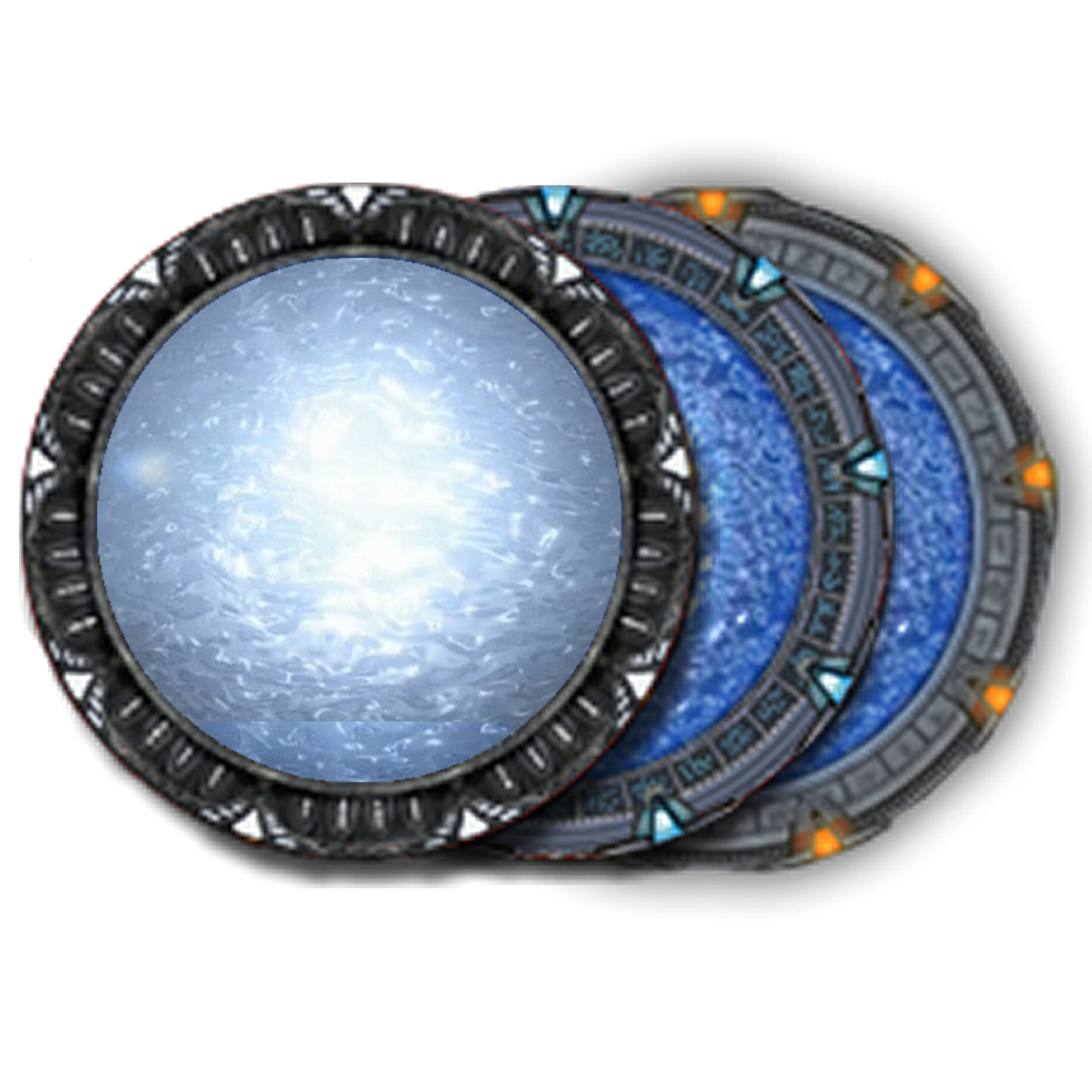Stargate franchise: Difference between revisions
| Line 59: | Line 59: | ||
Since the 304's creation, six such vessels have been constructed, including the ''[[Daedalus]]'', ''[[Odyssey]]'', ''[[Korolev]]'', ''[[Apollo]]'', ''[[Sun Tzu (spaceship)|Sun Tzu]]'', and ''[[George Hammond (spaceship)|George Hammond]]''. These ships are one of the most advanced creations in the [[Tau'ri]]'s possession. 304s are the ultimate culmination of everything the [[Stargate Program]] sought to achieve— the acquisition of technology capable of defending Earth from its enemies. These ships far rival the spaceships of most races in the Stargate universe and have ascended the Tau'ri to a place of major power in two galaxies (the [[Milky Way]] and [[Pegasus]]). These ships, and the Tau'ri themselves, became even more powerful in ''Stargate SG-1's'' series finale "[[Unending]]" after the demise of the [[Asgard]] — an extremely advanced race of humanoids, and perhaps the closest ally of Earth. In order to carry on their legacy after their subsequent demise, the Asgard gifted to the Tau'ri their complete history in an advanced [[Asgard computer core|computer core]], which also contained the knowledge to construct advanced Asgard technology. 304s have appeared in all three series, but most notably in Stargate SG-1 and Stargate: Atlantis. However, spaceships in the Stargate series largely only serve as plot devices to facilitate the progression of an episode, and very few episodes have taken place solely aboard spaceships, with the exception of ''[[Stargate Universe]]''. |
Since the 304's creation, six such vessels have been constructed, including the ''[[Daedalus]]'', ''[[Odyssey]]'', ''[[Korolev]]'', ''[[Apollo]]'', ''[[Sun Tzu (spaceship)|Sun Tzu]]'', and ''[[George Hammond (spaceship)|George Hammond]]''. These ships are one of the most advanced creations in the [[Tau'ri]]'s possession. 304s are the ultimate culmination of everything the [[Stargate Program]] sought to achieve— the acquisition of technology capable of defending Earth from its enemies. These ships far rival the spaceships of most races in the Stargate universe and have ascended the Tau'ri to a place of major power in two galaxies (the [[Milky Way]] and [[Pegasus]]). These ships, and the Tau'ri themselves, became even more powerful in ''Stargate SG-1's'' series finale "[[Unending]]" after the demise of the [[Asgard]] — an extremely advanced race of humanoids, and perhaps the closest ally of Earth. In order to carry on their legacy after their subsequent demise, the Asgard gifted to the Tau'ri their complete history in an advanced [[Asgard computer core|computer core]], which also contained the knowledge to construct advanced Asgard technology. 304s have appeared in all three series, but most notably in Stargate SG-1 and Stargate: Atlantis. However, spaceships in the Stargate series largely only serve as plot devices to facilitate the progression of an episode, and very few episodes have taken place solely aboard spaceships, with the exception of ''[[Stargate Universe]]''. |
||
== ''Stargate'' and ''Stargate SG-1'' == |
|||
[[File:Stargate SG-1 logo.jpg|thumb|250px|right|The ''[[Stargate SG-1]]'' title screen.]] |
|||
The whole premise of the ''Stargate'' franchise began with the feature film [[Stargate (movie)|''Stargate'']], released theatrically in [[1994]] by [[MGM]]. It was directed by [[Roland Emmerich]], written by Emmerich and [[Dean Devlin]] and starred [[Kurt Russell]], [[James Spader]] and [[Jaye Davidson]]. The film served to introduce the Goa'uld as the main antagonists and introduced the Stargate itself. However, several aspects of the film differ from the series (see [[Stargate canon]]). |
|||
''[[Stargate SG-1]]'' is a television spin-off of [[Roland Emmerich]]'s [[1994]] film ''[[Stargate (movie)|Stargate]]''. The series was developed for television by [[Brad Wright]] and [[Jonathan Glassner]], who together wrote the two-hour pilot episode "[[Episode:Children of the Gods|Children of the Gods]]", which was set to take place more than one year after the events of the movie. "Children of the Gods" originally aired on July 27, [[1997]] and "[[Episode:Unending|Unending]]," the final episode of the series, aired in the [[United Kingdom|UK]] on March 13, [[2007]] and in the [[United States|US]] on June 22, [[2007]]. |
|||
=== Overview === |
|||
Although an overall story arc was present from the start, the episodes of the first few seasons of Stargate SG-1 were mostly episodic, depicting the SG-1 team traveling to a different [[planet]] in each episode. Occasionally, this formula was broken slightly, usually when they dealt with [[NID]] agents, in which case the episode would take place mostly on [[Earth]]. Gradually, the show became less episodic and more serialized. Over its ten-year run, the show built up a complex mythology involving the history of the [[galaxy]] and introduced many new alien races, such as the [[Ancient]]s and the [[Asgard]], whereas the only true alien to appear in the original film was [[Ra]]. |
|||
Originally, the Goa'uld, namely [[Apophis]], were the principal villains of the series. However, at the end of season three a new threat was introduced, the [[Replicators]]. Although they appeared in multiple episodes over the next five seasons, they were never as widely depicted as the Goa'uld were. In "[[Episode:Enemies|Enemies]]," the opening episode of season five, Apophis was finally defeated and [[Anubis]] replaced him as the main villain for the next three seasons. Anubis and the Replicators were defeated in one blow at the end of season eight. Even though the Goa'uld were not completely destroyed, a new race called the [[Ori]] became the principal villains for the show's final two seasons. |
|||
The tone of the show also changed considerably over the course of its run. Much like the original film, the earlier episodes were mostly serious in character with an underlying comic tone. Later, the show became much lighter and occasionally even verged on borderline self-parody. The introduction of the Ori in season nine and the additions of Claudia Black and Ben Browder continued the show in its comedic and light hearted aspects. |
|||
=== Goa'uld === |
|||
[[File:Goa'uld symbiote.jpg|thumb|right|250px|A [[Goa'uld]] symbiote.]] |
|||
The ''[[Goa'uld]]'' are a race of sentient parasitic, snake-like beings that can take over the host bodies of a variety of species. The Goa'uld served as the main antagonists for the first eight seasons of Stargate SG-1 until they were largely defeated in the episode [[Episode:Reckoning, Part 2|"Reckoning", Part 2]]. They are also extremely ego-maniacal due to their [[genetic memory]] and the [[sarcophagus]] technology. Races that refused to serve them would be completely destroyed without compromise ([[SG1]]: "[[Episode:Children of the Gods|Children of the Gods]]", "[[Episode:Thor's Hammer|Thor's Hammer]]", "[[Episode:The First Ones|The First Ones]]"). The [[Goa'uld]] served largely as the driving force for Stargate SG-1 in its early seasons. The constant Goa'uld threat resulted in the [[Stargate Command|SGC]]'s mandate to acquire technology capable of defending the planet from them. |
|||
The Goa'uld themselves are small snake-like [[Symbiote]]s that require a host body ([[SG1]]: "[[Episode:Children of the Gods|Children of the Gods]]"). Once they burrowed into body which can be accomplished by piercing the skin in the neck, the parasite begins to wrap itself around the Human spine. The symbiote then weaves itself around the nervous system where thin filaments are extended that go up into the brain itself ([[SG1]], "[[Episode:The Enemy Within|The Enemy Within]]"). Within a host, a Goa'uld parasite has complete control of the host's body. A Goa'uld also gives its host near perfect health, increased strength, and increased intelligence. The highest authority among the Goa'uld race included the ranks of the [[System Lord]]s, who fielded vast armies and fleets of ships under their command as well as warred with one another for dominance of the galaxy. |
|||
The strength of the Goa'uld's power was the millions of [[Jaffa]] they kept subservient to them by assuming the persona of their "gods". These Jaffa were eventually the Goa'uld's undoing. When the numbers of [[Jaffa Rebellion|rebel Jaffa]] grew, they were eventually (with massive help from the Tau'ri) able to overthrow their Goa'uld masters and establish a [[Free Jaffa Nation]]. Because of this, the Jaffa nation has become a powerful force with a fleet of former Goa'uld ships in their possession. They are sporadic allies of the Tau'ri due to rising political turmoil. |
|||
=== Ori === |
|||
[[File:Ori.jpg|thumb|right|250px|An [[Ori]] in its [[Ascension|ascended]] form.]] |
|||
The ''[[Ori]]'' were a race of ascended beings who used their knowledge and power as justification to demand the worship of mortal beings. Millions of years ago, the Ori lived together with the [[Ancients]] as a single, united society in a [[Ori home galaxy|distant galaxy]] as the '''''[[Alterans]]'''''. Unfortunately, at some point, a [[Alteran division|split]] occurred among the Alterans: The Ancients began to devote themselves to science, while the Ori became more and more religious. This division eventually became so great that the Ori attempted to destroy the Ancients. To avoid a war, which was contradictory to their beliefs, the Ancients departed their home galaxy for the [[Milky Way]]. |
|||
The Ori conceived the [[Origin]] faith, one that puts them in the center of creation, and wrote down their word in the [[Book of Origin]] to be administered to followers through [[Prior]]s, missionaries and teachers of Origin. The Ori use the [[Doci]], the chief Prior, as their "mouthpiece" for communicating with lesser beings. They are able to possess his body to spread their demands and will ([[SG1]]: [[Episode:Avalon, Part 2|"Avalon", Part2]], "[[Episode:Origin|Origin]]"). |
|||
The Ori serve as the main antagonists for Stargate SG-1 in [[Stargate SG-1 Season 9|seasons 9]] and [[Stargate SG-1 Season 10|10]]. After being discovered by [[Daniel Jackson]] and [[Vala Mal Doran]], the Ori were subsequently alerted to the presence of humans in the Milky Way galaxy, and began a religious crusade in an effort to convert the galaxy's population to [[Origin]]. In season 10, the Ori manage to sent a fleet of [[Ori warship|warships]] to the Milky Way, capable of rivaling even the most advanced spaceships. However, in the SG-1 series finale, the Tau'ri were gifted the most advanced [[Asgard]] [[Asgard shield|shield]] and [[Asgard plasma beam weapon|weapon]] technology, capable of successfully combating Ori ships. |
|||
Several attempts to destroy the Ori and their followers have taken shape, such as by searching for and using Ancient technology, such as the [[Sangraal]] and [[Ark of Truth]]. The [[Sangraal]] (which SG-1 searched for through the last half and season nine and the first half of season ten) is an Ancient device that is capable of, and was used to, destroy the Ascended Ori. However, despite the Ori themselves dieing in Season 10's "[[Episode:The Shroud|The Shroud]]", their followers were still very much a threat and were still carrying on their [[Ori crusade|crusade]] (oblivious to the fact that their "gods" were dead). The Ori story arc came to a conclusion in the Direct-to-DVD movie ''[[Stargate: The Ark of Truth]]'', in which SG-1 travels to the [[Alteran Home Galaxy|Ori's galaxy of origin]] (via the ''[[Odyssey]]'') and finds an ancient device known as the [[Ark of Truth]]. This device, when found, was used to show the followers of Origin the faults of the religion, thus ending the Ori campaign and story arc. |
|||
Revision as of 18:41, 31 January 2016
| Stargate | |
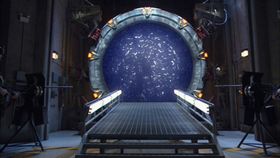 An active Stargate, the main device used in the franchise. | |
| Creator | Roland Emmerich, Dean Devlin |
|---|---|
| Original work | Stargate |
| Print publications | |
| Novels | Novels |
| Comics | Comics |
| Films and television | |
| Films | Stargate Stargate: The Ark of Truth Stargate: Continuum |
| Television series | Stargate SG-1 Stargate Atlantis Stargate Universe |
| Animated series | Stargate Infinity |
| Games | |
| Role-playing | Stargate SG-1 Roleplaying Game |
| Video games | Stargate: Resistance |
Stargate is an adventure military science fiction franchise, initially conceived by Roland Emmerich and Dean Devlin. The first film in the franchise was simply titled Stargate. It was originally released on October 28, 1994, by Metro-Goldwyn-Mayer, Carolco and Studio Canal, and became a hit, grossing nearly $200 million (USD) worldwide.[1][2] Three years later, Brad Wright and Jonathan Glassner created a television series titled Stargate SG-1 as a sequel for the film.
In addition to film and television, the Stargate franchise has expanded into other media, including books, video games, and comic books. These supplements to the film and television series have resulted in significant development of the show's fictional universe and mythology. In 2008, the films Stargate: The Ark of Truth and Continuum were released direct-to-DVD, which in total grossed over $21 million in the United States. In 2002 the franchise's first animated series, Stargate Infinity, began airing, which holds no canonicity in the franchise despite its Stargate SG-1-inspired plot. In 2004, the TV series Stargate Atlantis was released as a spin off from Stargate SG-1 and a third series, Stargate Universe, premiered on October 2, 2009. Stargate Universe was cancelled during its second season, leaving it on a cliffhanger. Then on April 17, 2011, Stargate producer Brad Wright announced that any plans for the continuation of the franchise had been cancelled indefinitely, ending 17 years of Stargate television production.[3]
Premise
Stargate productions center on the premise of a "Stargate", a ring-shaped device that creates a wormhole enabling personal transportation to complementary devices located cosmic distances away. Under the control of the United States government, the Stargate discovered on Earth is kept a secret from the public. This allows for storylines to present no contradiction between depicted events and reality, an effect compounded by setting Stargate in the present day and depicting Earth accurately, with any unrealistic technology originating solely from alien civilizations. These extraterrestrial civilizations are typically more pre-industrial than scientifically advanced and are almost always human. Together, this allows for stories predominated by human interaction in Earth-like environments, an unusual feature for a science fiction franchise focused on exploration of other worlds.
In the story, this is explained as being the result of alien interference in Earth's distant past—the concept influenced by the theories of Erich von Däniken.[4] Many ancient mythologies are shown to be the result of aliens who had visited Earth posing as gods by using their technology to give the impression of deific power. While some of these aliens had benign intentions, a race later known in Stargate SG-1 as the "Goa'uld" used Stargates to move slaves from Ancient Egypt to other habitable planets, simultaneously being responsible for the Egyptian religion and culture. Following a successful rebellion, the Goa'uld fled Earth, and the Stargate was buried and forgotten until modern times, when the United States acquired it following an archaeological dig. With the rediscovery of the function of the Stargate, the galaxy becomes a source of knowledge as well as threats, and the attention of the Goa'uld is drawn once more to Earth.
Stargate network
Several million years ago, an ancient race of advanced humanoid beings, now known as the Ancients, created a device capable of near-instantaneous transportation across the universe by means of a subspace wormhole. This device, which has been used by countless races since its creation, has more commonly become known as a "Stargate"— a name, discovered by Dr. Daniel Jackson, from hieroglyphics written by humans on Earth thousands of years ago. While various cultures have created their own name for the device, Stargate is among the most common used.
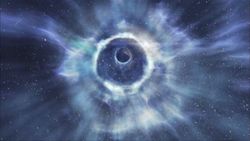
A Stargate itself is a device made out of a volatile mineral known as naquadah. It is between two Stargates that travel is possible. A stable wormhole in a Stargate is achieved by dialing the correct address in a mechanism named a DHD. In a DHD, an address of six symbols (representing constellations as seen from Earth for the Milky Way galaxy-style of gate) is imputed, plus a point of origin (a symbol unique to a particular Stargate that represents the location a person is dialing from), bringing the total up to seven symbols for an in-galaxy address. Eight symbols are required to establish a lock with a Stargate in another galaxy (such as the Pegasus galaxy). Nine symbols are required to dial Stargates that reside far across the universe - one notable destination is the gate aboard the Ancient spaceship Destiny, which was designed with the purpose of exploring the universe and Stargate networks established by the Seed ships that were launched prior. The Stargate contains nine chevrons spaced equally around its circumference. With each symbol that is locked, so is a chevron, making nine symbols the maximum number of symbols (or glyphs) that can be input. The design of the Stargates themselves tend to vary between galaxies. Three distinct designs are known; Stargates in the Milky Way galaxy, Pegasus galaxy, and that which resides on Destiny and are constructed by Seed ships. The varying designs of Stargates are largely the result of technological advancement; Destiny-style gates (the most primitive in design and function) were constructed first, followed by Milky-Way model gates, and lastly Pegasus-style gates.
Stargates play an extremely important role in each of the Stargate series. It is through these gates that races, mostly consisting of humanoid-like beings (particularly humans themselves), trade and explore. However, several races (such as the Goa'uld) often use the Stargate networks in far different, and deadlier, ways. Such races play an important role in the Stargate series, and are the driving force for the shows themselves.
Tau'ri
The Tau'ri are the main protagonists in the Stargate series. "Tau'ri" is the term used by the inhabitants of the Milky Way to refer to Earth and human beings from Earth. The word means "first ones" or "those from the first world" in the Goa'uld language in the sense that human life in the Milky Way began on Earth. While it originally applied to all human beings in the galaxy, the term has come to apply specifically to the humans who currently live on Earth as the Stargate Program proceeded to explore the galaxy. In the Stargate universe, the Tau'ri are the predominant protagonists in the fight against galactic oppressors, fighting a multi-front war against several other major races. During the first six years of the series, the Tau'ri were largely limited to what they could achieve in the way of repelling enemy forces due to the "primitiveness" of the technology in their possession, as compared to that of the hostile races they faced - notably the Goa'uld. It wasn't until season six and beyond that the Tau'ri were truly beginning to emerge as a powerful force in the galaxy (SG1: "Children of the Gods", "Thor's Hammer", "Red Sky", "Unending").
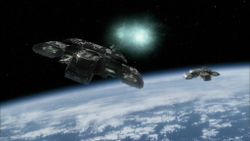
Around Stargate SG-1's sixth season, as a result of six years of exploration and discovery, the Tau'ri became powerful and knowledgeable enough to construct their first battlecruiser, the Prometheus, which was the sole member of the BC-303-class. Despite being rather primitive in comparison to the spaceships of most other races, this ship represented a massive step in the Tau'ri's development. Prometheus served as the flagship of the Tau'ri fleet for several years and lived long enough to see the downfall of the Goa'uld. Through it's existence, it played critical roles in Earth's defense (such as in the Battle of Antarctica). However, as the Tau'ri became more advanced towards the eight season of Stargate SG-1, the Prometheus-class series of vessels became exceedingly obsolete. Therefore, a new class of ship was designed, the 304, also known as the Daedalus-class after the first ship of the class.
Since the 304's creation, six such vessels have been constructed, including the Daedalus, Odyssey, Korolev, Apollo, Sun Tzu, and George Hammond. These ships are one of the most advanced creations in the Tau'ri's possession. 304s are the ultimate culmination of everything the Stargate Program sought to achieve— the acquisition of technology capable of defending Earth from its enemies. These ships far rival the spaceships of most races in the Stargate universe and have ascended the Tau'ri to a place of major power in two galaxies (the Milky Way and Pegasus). These ships, and the Tau'ri themselves, became even more powerful in Stargate SG-1's series finale "Unending" after the demise of the Asgard — an extremely advanced race of humanoids, and perhaps the closest ally of Earth. In order to carry on their legacy after their subsequent demise, the Asgard gifted to the Tau'ri their complete history in an advanced computer core, which also contained the knowledge to construct advanced Asgard technology. 304s have appeared in all three series, but most notably in Stargate SG-1 and Stargate: Atlantis. However, spaceships in the Stargate series largely only serve as plot devices to facilitate the progression of an episode, and very few episodes have taken place solely aboard spaceships, with the exception of Stargate Universe.
Stargate and Stargate SG-1
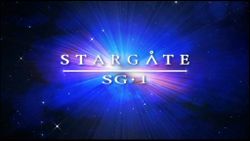
The whole premise of the Stargate franchise began with the feature film Stargate, released theatrically in 1994 by MGM. It was directed by Roland Emmerich, written by Emmerich and Dean Devlin and starred Kurt Russell, James Spader and Jaye Davidson. The film served to introduce the Goa'uld as the main antagonists and introduced the Stargate itself. However, several aspects of the film differ from the series (see Stargate canon).
Stargate SG-1 is a television spin-off of Roland Emmerich's 1994 film Stargate. The series was developed for television by Brad Wright and Jonathan Glassner, who together wrote the two-hour pilot episode "Children of the Gods", which was set to take place more than one year after the events of the movie. "Children of the Gods" originally aired on July 27, 1997 and "Unending," the final episode of the series, aired in the UK on March 13, 2007 and in the US on June 22, 2007.
Overview
Although an overall story arc was present from the start, the episodes of the first few seasons of Stargate SG-1 were mostly episodic, depicting the SG-1 team traveling to a different planet in each episode. Occasionally, this formula was broken slightly, usually when they dealt with NID agents, in which case the episode would take place mostly on Earth. Gradually, the show became less episodic and more serialized. Over its ten-year run, the show built up a complex mythology involving the history of the galaxy and introduced many new alien races, such as the Ancients and the Asgard, whereas the only true alien to appear in the original film was Ra.
Originally, the Goa'uld, namely Apophis, were the principal villains of the series. However, at the end of season three a new threat was introduced, the Replicators. Although they appeared in multiple episodes over the next five seasons, they were never as widely depicted as the Goa'uld were. In "Enemies," the opening episode of season five, Apophis was finally defeated and Anubis replaced him as the main villain for the next three seasons. Anubis and the Replicators were defeated in one blow at the end of season eight. Even though the Goa'uld were not completely destroyed, a new race called the Ori became the principal villains for the show's final two seasons.
The tone of the show also changed considerably over the course of its run. Much like the original film, the earlier episodes were mostly serious in character with an underlying comic tone. Later, the show became much lighter and occasionally even verged on borderline self-parody. The introduction of the Ori in season nine and the additions of Claudia Black and Ben Browder continued the show in its comedic and light hearted aspects.
Goa'uld
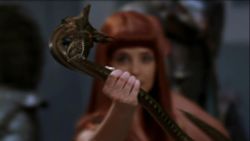
The Goa'uld are a race of sentient parasitic, snake-like beings that can take over the host bodies of a variety of species. The Goa'uld served as the main antagonists for the first eight seasons of Stargate SG-1 until they were largely defeated in the episode "Reckoning", Part 2. They are also extremely ego-maniacal due to their genetic memory and the sarcophagus technology. Races that refused to serve them would be completely destroyed without compromise (SG1: "Children of the Gods", "Thor's Hammer", "The First Ones"). The Goa'uld served largely as the driving force for Stargate SG-1 in its early seasons. The constant Goa'uld threat resulted in the SGC's mandate to acquire technology capable of defending the planet from them.
The Goa'uld themselves are small snake-like Symbiotes that require a host body (SG1: "Children of the Gods"). Once they burrowed into body which can be accomplished by piercing the skin in the neck, the parasite begins to wrap itself around the Human spine. The symbiote then weaves itself around the nervous system where thin filaments are extended that go up into the brain itself (SG1, "The Enemy Within"). Within a host, a Goa'uld parasite has complete control of the host's body. A Goa'uld also gives its host near perfect health, increased strength, and increased intelligence. The highest authority among the Goa'uld race included the ranks of the System Lords, who fielded vast armies and fleets of ships under their command as well as warred with one another for dominance of the galaxy.
The strength of the Goa'uld's power was the millions of Jaffa they kept subservient to them by assuming the persona of their "gods". These Jaffa were eventually the Goa'uld's undoing. When the numbers of rebel Jaffa grew, they were eventually (with massive help from the Tau'ri) able to overthrow their Goa'uld masters and establish a Free Jaffa Nation. Because of this, the Jaffa nation has become a powerful force with a fleet of former Goa'uld ships in their possession. They are sporadic allies of the Tau'ri due to rising political turmoil.
Ori

The Ori were a race of ascended beings who used their knowledge and power as justification to demand the worship of mortal beings. Millions of years ago, the Ori lived together with the Ancients as a single, united society in a distant galaxy as the Alterans. Unfortunately, at some point, a split occurred among the Alterans: The Ancients began to devote themselves to science, while the Ori became more and more religious. This division eventually became so great that the Ori attempted to destroy the Ancients. To avoid a war, which was contradictory to their beliefs, the Ancients departed their home galaxy for the Milky Way.
The Ori conceived the Origin faith, one that puts them in the center of creation, and wrote down their word in the Book of Origin to be administered to followers through Priors, missionaries and teachers of Origin. The Ori use the Doci, the chief Prior, as their "mouthpiece" for communicating with lesser beings. They are able to possess his body to spread their demands and will (SG1: "Avalon", Part2, "Origin").
The Ori serve as the main antagonists for Stargate SG-1 in seasons 9 and 10. After being discovered by Daniel Jackson and Vala Mal Doran, the Ori were subsequently alerted to the presence of humans in the Milky Way galaxy, and began a religious crusade in an effort to convert the galaxy's population to Origin. In season 10, the Ori manage to sent a fleet of warships to the Milky Way, capable of rivaling even the most advanced spaceships. However, in the SG-1 series finale, the Tau'ri were gifted the most advanced Asgard shield and weapon technology, capable of successfully combating Ori ships.
Several attempts to destroy the Ori and their followers have taken shape, such as by searching for and using Ancient technology, such as the Sangraal and Ark of Truth. The Sangraal (which SG-1 searched for through the last half and season nine and the first half of season ten) is an Ancient device that is capable of, and was used to, destroy the Ascended Ori. However, despite the Ori themselves dieing in Season 10's "The Shroud", their followers were still very much a threat and were still carrying on their crusade (oblivious to the fact that their "gods" were dead). The Ori story arc came to a conclusion in the Direct-to-DVD movie Stargate: The Ark of Truth, in which SG-1 travels to the Ori's galaxy of origin (via the Odyssey) and finds an ancient device known as the Ark of Truth. This device, when found, was used to show the followers of Origin the faults of the religion, thus ending the Ori campaign and story arc.
- ↑ "Stargate (1994)". ''Box Office Mojo. Retrieved 2011-04-27.
- ↑ "Movie Stargate - Box Office Data, News, Cast Information - The Numbers". Nash Information Services, LLC.
- ↑ Colvin, Chad (April 17, 2011). "SGU continuation, other movies dead — for now". GateWorld. Retrieved April 17, 2011.
- ↑ "Roland Emmerich's Stargate film based on Erich von Daniken's research". Zoozle news. Retrieved March 19, 2011.
